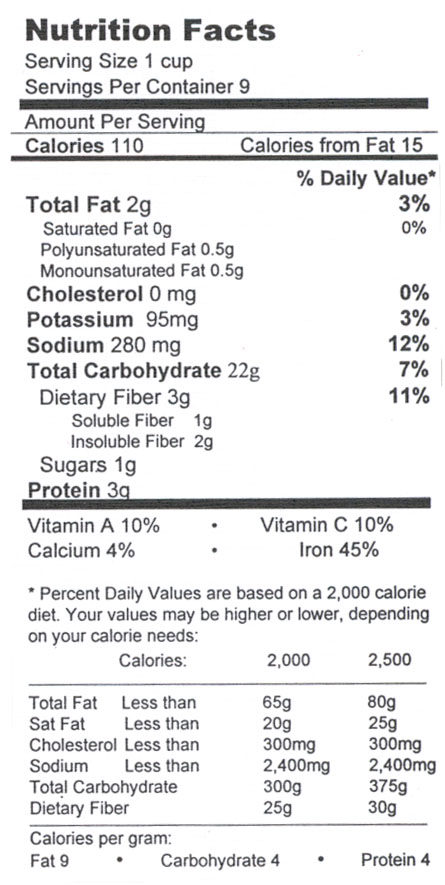| |
|
Reading Food Labels
A Healthy Hearts Guide
|
|
|
|

|
Can you tell which foods are heart healthy? Do you wonder how
you can fit your favorite foods into your diet? It's EASY!
By reading labels and looking at total grams of fat and saturated fat, and avoiding all trans-fat,
you can enjoy your favorites. Here's how...
|
|
|
1. Check how much fat you can have each day
Ask your healthcare professional what percentage of total fat is right for you.
Then, refer to the Healthy Hearts Guide COUNT YOUR FAT GRAMS WORKSHEET.
My total daily allowance of fat grams is__________.
2. Look at how much of your total fat can be saturated fat
Health experts agree that it is important to limit saturated fats to less than 1/3
of your total daily fat gram allowance. Divide your total fat allowance by three.
This is how much of your total fat should come from saturated fats.
My daily allowance of saturated fat is__________.
3. Examine the label
(Refer to the label at the right)
-
Find the serving size.
-
Find the number of grams of fat for one serving size (listed as
"Total Fat").
-
Under Total Fat, find the grams of Saturated Fat.( The Grams of
saturated fat are part of the total fat.
-
Don't take in any trans-fat. You may not find trans-fat listed on food labels, so read the small print in the ingredients section and if the product contains partially hydrogenated oils, BOYCOTT that product!
|

|
Now Decide!
Does this product fit into your daily fat allowance? Do you want to adjust your food
intake the rest of the day? Limiting certain foods and finding substitutes is key to a heart healthy
eating plan.
Consume a diet rich in fruits and vegetables; choose whole-grain, high-fiber foods; consume fish, especially oily fish,* at least twice a week. Limit intake of saturated fat to <10% of energy, and if possible < 7%, cholesterol to < 300 mg/d, alcohol intake to no more than 1 drink per day and sodium intake to < 2.3 g/d (approx 1 tsp salt). Consumption of trans-fatty acids should be as low as possible, but reading food labels for trans-fat content is not enough. You must read the fine print in the ingredients section and avoid products with "partially hydrogenated oil", found in stick margarine, commercial baked goods and most snack foods.
You can reduce your intake of saturated fat by removing the skin from
poultry, choosing extra-lean meats, and limiting high-fat milk products,
including butter and cheese. You can avoid hydrogenated or partially hydrogenated fat (known to contribute to heart disease even more than saturated fats)
by not eating hard stick margarine,
commercial baked goods, snack foods, and processed peanut butter.
Replace unhealthy fats with heart-healthy monounsaturated fats like olive, canola and peanut
oil. These fats protect HDL - the “Good” cholesterol. Taking in 2-3 Tablespoons of olive oil each day can help raise HDL level- the "healthy" cholesterol. Other ways you can raise HDL levels include
engaging in regular aerobic activity, maintaining a healthy weight and quitting smoking.
Try pour-able or spray margarines, no-fat or low-fat salad
dressings, no-fat or light sandwich spreads, cooking sprays, light butter and skim
or low-fat milk.
Increase dietary fiber. Foods with soluble fiber can help to lower blood cholesterol.
Aim for 25-30 grams of fiber a day, 1/4 of which should consist of
soluble fiber and 3/4 from insoluble fiber. Soluble fiber is found primarily in
oats, beans, fruits and vegetables. Read the food label for content of both
soluble and insoluble fiber.
Note: Pregnant and lactating women should avoid eating fish potentially high in methylmercury (eg shark, swordfish, king mackerel or tile fish) and should eat up to 12 oz/wk of a variety of fish and shellfish low in mercury. Check the Environmental Protection Agency and the US Food and Drug Administration's Web sites for updates and local advisories about safety of local catch.
|
Reading Food Labels
|
Counting Fat Grams
|
Fats and Cholesterol
|
Becoming a Leaner Cook
|
Dietary Supplements
|
The DASH Diet
|
Healthy Lifestyle
|
Mediterranean Diet
|
Nutrition and Health
|
Diet and Exercise Log
Back to top
Disclaimer | Donate Now | Contact Us | Site Map | Store
|
©1999-2000; updates: 2002, 2004, 2005, 2007 Women's Heart Foundation, Inc. All rights reserved.
Unauthorized use prohibited. The information contained in this Women's
Heart Foundation (WHF) Web site is not a substitute for medical advice or
treatment, and WHF recommends consultation with your doctor or health care
professional.
|
|
|
|
|

























